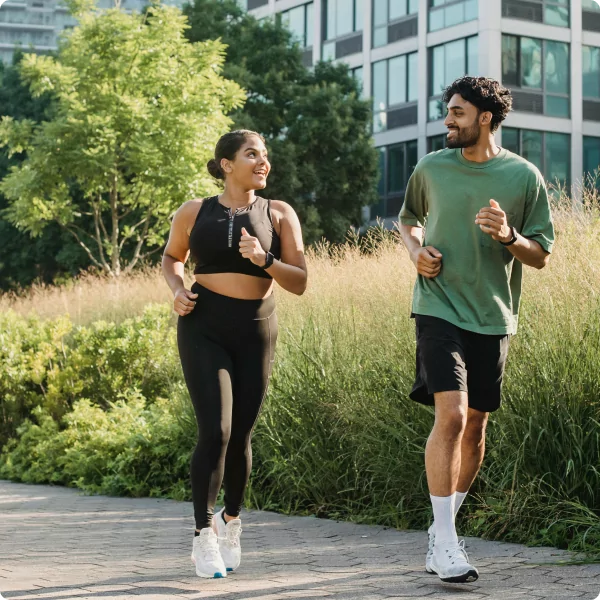
Introduction and Considerations
In the 21st century, modern living has become centered around a sedentary and indoor lifestyle, contributing to an international sedentary epidemic.
We know that daily movement will have a positive effect on our body’s ability to function optimally. Movement such as walking and running can have positive health benefits on our bodies, such as:
- Improved cognitive performance and overall brain function
- Improved cardiovascular system
- Improved metabolic health
- Improved bone mineral density
- Improved mood and overall well-being
- Reduced risk of diabetes, obesity and other health conditions
- Improved social networking
Walking and running are the two most common methods of exercise we as individuals do, and they have shown to positively influence individuals’ health across all ages and genders. Research has also suggested that individuals with regular exposure to or living near open green areas or parks will more likely increase their engagement in movement, which could include walking and/or running. Before considering your transition from walking to running, it is important to pause and reflect on your current fitness levels. Some things to consider prior to engaging with your transition include:
- Do you need to consult with a medical professional before starting this transition?
- Are you currently carrying any serious health conditions or injuries that can be made worse through exercise or increased exercise intensity?
- Are your current fitness levels at a stage that suggests you’re ready to increase your exercise intensity/duration?
- What are your immediate goals that you’ve set with regards to the transition from walking to running?
Preparing for the Transition
Before considering your transition from walking to running, there are some immediate factors you should consider:
- Realistic goal setting/expectations – Make sure you are setting realistic goals based on your current walking ability. Whether you’re coming back from injury or an operation or aiming to improve your general fitness levels, start off with realistic goals or expectations for your first few sessions. It’s obvious to point out that you shouldn’t expect to be setting any world records on your first few sessions.
- Choosing the right footwear – This is an obvious one to many but one that can easily be overlooked. What you’ve likely been wearing for walking won’t necessarily be suitable for your run/walk sessions as your walking to running gait changes. My recommendation is to visit your local, friendly running shop who will hopefully assess your feet and running gait and help you find a suitable set of running shoes to begin your transition from walking to running.
- Don’t forget to warm up! – Again, another obvious one but so many individuals are choosing to skip this section of their transition. Warming up can help prepare your body for the work that is about to follow. It will help to reduce the risk of injuries and help to improve your performance in your training sessions. Depending on the nature of the training session and the individual’s personal ability/circumstances, the warm-up duration and style will vary – but please make sure you are doing something before you start your session – your body will thank you for it.
- Take your time – This is important to ensure you don’t push your mind and body too far too soon. If you’re unsure about how much you should or shouldn’t be doing, please consult a registered and licensed professional. Additionally, please listen to your mind and body and gradually ease your way into your walk to running programme.
What Plan Should I Do?
In terms of making a safe transition, there are many free and accessible programmes available to those who are ready to begin making their transition from walking to running. Some of the immediate plans I would recommend beginners look to follow to ensure a safe and gradual transition between walking to running include:
- NHS Couch to 5K
- Jog Scotland’s Learn to Run Programme
- Runner’s World 10-week walk-jog-run plan
*Please note there are likely more programmes available to help you with your transition; however, many are not specifically designed to help you transition from walking to running, so please do take care when you’re finding a plan. If you are unsure, please consult a qualified and licensed fitness professional.
Once you have chosen a plan – commit to it. Do not give up after a few sessions or a few weeks. New habits and behaviours can take a lot longer to establish and it may be a few weeks/months before you start to see some improvements. Persevere with the programme and monitor your progress.
Additional considerations
- Take your time – Your transition from walking to running will be personal to you. It is important that you take your time and do not rush the process. Listen to your mind and body and respond accordingly.
- Nutrition & Hydration – Naturally, with the transition from walking to running, your energy expenditure will likely increase. It is important that you meet this increase in energy expenditure with energy intake to support health and performance.
- Anticipate potential barriers:
- Living in the UK, we’re not fortunate enough to have lots of nice weather. Don’t let this put you off getting your sessions done. Consider doing an indoor session or moving the time of your session to when weather conditions are going to be better suited to you.
- If you have additional responsibilities, e.g., work commitments, children, etc., make sure you schedule your sessions to allow consistency with your transition as you work your way up to running. Sometimes, the sessions can take time, so it’s important you plan this time in advance to allow progress to continue to be made.
Summary
Everyone’s transition from walking to running will be different and highly personal to them. Take your time with the transition and ensure you’re well prepared. Always ensure you are prioritising your health and listening to your body. Don’t forget to invest in suitable equipment and fuel and hydrate your body accordingly to reflect the intensity and duration of your walking to running sessions. If you’re unsure about anything and need more advice, make sure you consult a registered and licensed fitness/health professional.
References
Abe, D., Fukuoka, Y., & Horiuchi, M. (2019). Why do we transition from walking to running? Energy cost and lower leg muscle activity before and after gait transition under body weight support. PeerJ.
NHS. (2025). NHS. Retrieved from NHS – Better Health. Let’s Do This: https://www.nhs.uk/better-health/get-active/get-running-with-couch-to-5k/
Scotland, J. (2025). Jog Scotland. Retrieved from Jog Scotland – Learn to Run or Walk for Fitness: https://jogscotland.org.uk/joggers/learn-to-run-or-walk-for-fitness/
Tretyakova, V. D. (2023). WALKING AND RUNNING IN THE CONTEXT OF THEIR IMPACT ON BRAIN HEALTH AND COGNITIVE FUNCTION. Network Scientific Journal, 277-296.
Wolf, I. D., & Wohlfart, T. (2014). Walking, hiking and running in parks: A multidisciplinary assessment of health and well-being benefits. Elsevier, 89-103.
Runners World, R. (2025). Runners World. Retrieved from A 10-week walk-jog-run plan for complete beginners: https://www.runnersworld.com/uk/training/beginners/a30279918/run-walk-plan-complete-beginners/









